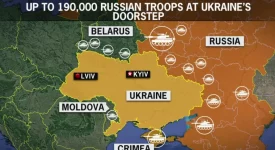Over the past two and a half years of the Syrian civil war, an increasing number of European Muslims have left to fight on the side of the rebels against the oppressive Assad regime. Although their precise number and origin are unknown, Western governments are advised to pay a close attention to this problem, because these foreign fighters may then potentially turn their eyes to, and vent their ‘anger’ and ‘frustration’, in their home countries in the West. While European governments are trying to assess the scale of potential threat these fighters could pose to their countries’ internal security, researchers are trying to come up with at least rough estimate of how many Muslim radicals could have left Europe in order to join the conflict in Syria.
There are generally two methods being used for getting an estimate of the gross number of departing fighters. The first technique is collecting all conceivable types of open-source reports of their flows ranging from aggregate estimates from the United Nations to particular martyrdom notices. The second one is using figures of intelligence services reports of particular countries. Whereas the first strategy does not really allow the authorities to produce a comparable country-level dataset, the second method is more reliable and perhaps more rigorous, yet rather limited in its scope. Moreover, in both these cases, neither accuracy nor the methodology of data collation can be considered straightforward and trouble-free. Yet, the latter method seems to have a slightly bigger potential since intelligence services have a wider range of collection tools and techniques at their disposal than academic circles do, especially given the fact that European agencies have been quite active in tracking their respective foreign fighters since the onset of the Syrian conflict in 2011.
Using the information of intelligence services in twelve European countries, the absolute number of foreign Muslim fighters in Syria is the highest in France with estimated minimum of 200 and maximum of 400 fighters that have left so far. France is followed by Germany (200), Great Britain (min 200, max 300), and Belgium (min 100, max 300). The lowest figures are from the Scandinavian countries and the Netherlands with average 40 fighters per country. Although the relative numbers do not tell us much about the real scope and extent of pro-Syrian radicalism in European countries without accounting for the size of their respective Muslim populations, it is noteworthy that the cumulative maximum absolute number speaks of 1,700 fighters and the lowest about 1,100. Hence, it is very likely that the twelve countries, with Bosnia being the only non-EU country in the sample, are the main base of foreign fighters in Syria, although a number of other countries are believed to participate too.
Importantly, if we were to believe that at least 1,200 European Muslim fighters have gone to fight, then we talk about the largest European Muslims foreign fighter contingent to any conflict in the Old Continent’s modern history. In fact, the number of European fighters in the two-and-a-half year long war in Syria may exceed the total number of Muslim foreign fighters from all Western countries to all conflicts between 1990 and 2010. As a result, the problem of potential attacks from foreign fighters returning back from Syria is not equally serious for all countries from which they hail. Indeed, absolute figures are not the best indicator of the scale of the potential threat as larger countries have more resources to throw at the problem. Ten prospective terrorists constitute a far greater problem for Luxembourg than for the United States. However, when we control the overall size of the population and count the number of foreign fighters per million inhabitants, we get a slightly different picture. In relative terms, the leading source of foreign Muslim fighters is Bosnia with almost 16 fighters per million inhabitants, followed by Denmark with almost 12 per million, and Belgium with almost 9. In contrast, Germany “provides” only 2.5 fighters, and France and Great Britain 3.1 each.
If we assume that the proportion of foreign fighters who return to carry out a terrorist attack on their home turf is the same for each contingent, and that population size of individual EU states is a reasonable proxy for peacetime policing capacity, then these numbers say something about the relative effort each country will need to exert to handle the problem of these ‘jihad tourists’. Yet, these numbers still do not tell us much about the relative scale of radicalization problem within the various Muslim populations in Europe mainly due to the relative size of the Muslim population that varies across countries. For instance, both Britain and France have a very similar size of their populations, but the French Muslim population is somewhat 65 percent bigger than that of the UK. Moreover, to further complicate any analysis into this complex topic, not all foreign fighters are radicalized Muslims, and not all radicalized Muslims are actually interested in foreign fighting.
Article Tags:
Belgium · Bosnia · France · Germany · Great Britain · Netherlands · Syria · United Nations · USArticle Categories:
SECURITY & DEFENSE






